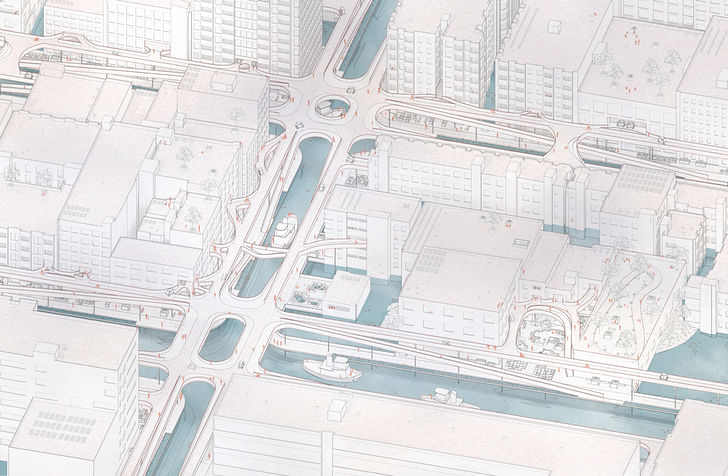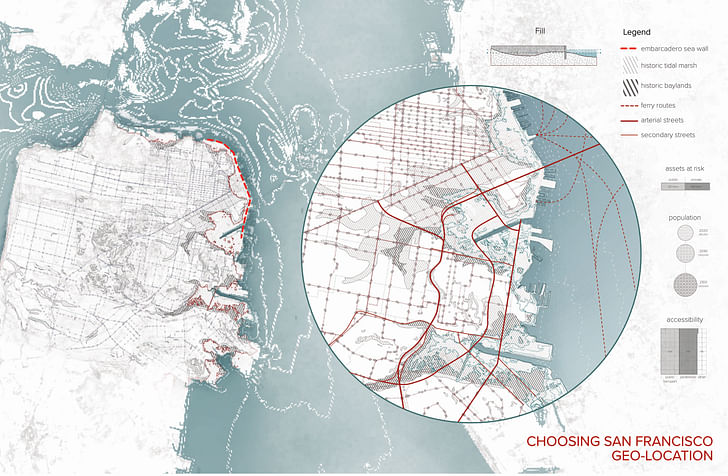

Kate Katz and Ryan Shaaban are recent graduate students from Tulane University's 5-year M.Arch program. Together the two explore the impact of rising sea levels and alternative approaches to coastal city infrastructure. According to both students, their thesis "strives to change the perception of how we as humans relate to nature by accommodating the dynamic qualities of water into the urban grid network."
Archinect connected with Katz and Shaaban to learn more about their final thesis project, their experience transitioning to remote learning, and their thoughts on graduating during a global pandemic. Their project was selected to be featured in Tulane's 2020 Thesis Show and chosen as one of the top four presentations in their graduating class.
Archinect's Spotlight on 2020 Thesis Projects: 2020 has been an extraordinarily challenging year for architecture graduates. Students were displaced as schools shut down, academic communities had to adapt to a new virtual format, end-of-year celebrations were canceled or changed dramatically, and now these students are graduating into an extremely challenging employment market. To support the 2020 class we're launching a summer series of features highlighting the work of thesis students during this unique time of remote learning amid COVID-19. Be sure to follow our 2020 thesis tag to stay up to date as we release new project highlights.

...[we] focused on the issues of global sea level rise for coastal cities, using San Francisco as an urban prototype to inspire a new approach cities can implement to accommodate and engage with future inundation.
Briefly describe your thesis.
My partner, Ryan Shaaban, and I focused on the issues of global sea level rise for coastal cities, using San Francisco as an urban prototype to inspire a new approach cities can implement to accommodate and engage with future inundation. It looks critically at traditional infrastructures such as sea walls that not only serve as disengaging monofunctional barriers, but also contribute to environmental degradation.
As we accommodated the new format of a digital presentation we decided to rethink our narrative into displaying the development of our system that would become a framework for further investigation.
How did your project change as studios transitioned to remote learning?
Before the transition to remote learning, our project focused on showcasing our narrative through a three-dimensional section that would place the reviewer into our envisioned landscape of San Francisco. As we accommodated the new format of a digital presentation we decided to rethink our narrative into displaying the development of our system that would become a framework for further investigation. This allowed us to focus on the conceptual and technical details in our project rather than concentrating on how to achieve the physical exhibition we originally planned.
It is important to consider how your project can be integrated with other disciplines.
Any tips for students working through their final projects?
It is important to consider how your project can be integrated with other disciplines. Throughout our process, we consulted professionals in the field of landscape architecture, the school of environmental science, along with faculty that have experience in infrastructural design. These conversations allowed us to broaden our goals for the proposal while gaining valued input that steered our project in directions we never would have considered. When it comes to producing the final presentation, make a list of deliverables and a schedule for yourself so you have time to go over final touches at the end. Also, think ahead in terms of how you can take those deliverables and optimize them for different digital formats such as social media platforms and publications.
The ability to build is a costly endeavor, the pandemic, and associated recession have shed light on how architecture is not insulated from social and economic impacts but also how it is a valued resource.
As recently graduated students, how do you feel about the architecture industry right now and job prospects?
The ability to build is a costly endeavor, the pandemic, and associated recession have shed light on how architecture is not insulated from social and economic impacts but also how it is a valued resource. We have had different opportunities for work during this time, allowing us to reflect on our interests within the profession. Throughout it all, we have kept our perspectives open to how our careers can develop and how we can best apply our expertise from school to opportunities in the present and future.
Katherine is an LA-based writer and editor. She was Archinect's former Editorial Manager and Advertising Manager from 2018 – January 2024. During her time at Archinect, she's conducted and written 100+ interviews and specialty features with architects, designers, academics, and industry ...
1 Comment
i'm glad to see projects giving serious and realistic thought to the reality that coastal cities will be flooded. in a lot of ways this seems technically and economically impractical, but it has the worthwhile attitude of looking for pragmatic improvements on the obvious solutions. the presentation graphics are wonderfully keeping in that character of being plain and rational - free of the non-sense utopianistic renderings prevalent in contemporary professional media.
Block this user
Are you sure you want to block this user and hide all related comments throughout the site?
Archinect
This is your first comment on Archinect. Your comment will be visible once approved.